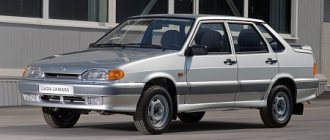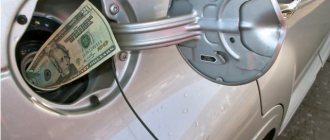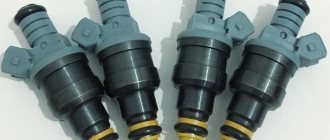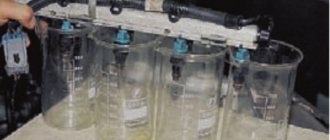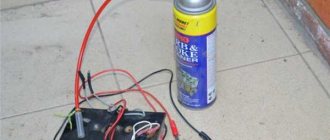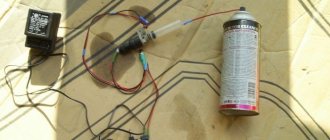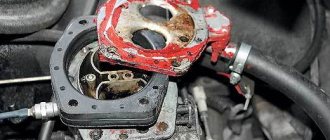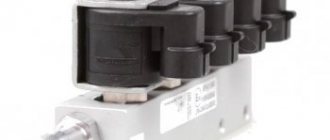Last updated May 28, 2022 at 10:40 am
Starting with the third version of gas equipment, the function of supplying fuel (methane, propane-butane mixture) to the combustion chambers of the engine began to be performed by special mechanical injectors. 4th generation HBO gas injectors are on a completely different level. Thanks to electronic control and fine-tuning, it has become possible to more efficiently use gas systems in cars.
A gas kit for installation on a car is often assembled from a set of parts from different manufacturers. Which injectors are better to install and how to choose them, as well as install them correctly, we will tell you in this article.
General concepts
LPG or gas equipment (approved abbreviation - LPG) is additional equipment for a car, the purpose of which is to store and supply fuel in a gaseous state to the internal combustion engine.
This type of fuel includes methane and a mixture of butane and propane. There are six generations of gas equipment. Differences between HBO generations in gas supply and regulation systems (injector, carburetor). 4th generation HBO injectors are an equipment unit that is used in parallel or distributed sequential injection of a mixture into an engine. Its task is to dose the fuel.
About Lovato
The first Lovato workshops, named after Ottorino Lovato, appeared in Vincenza (Italy) in 1958. In 2007, Lovato workshops became known as Lovato Gas, and in 2008 Lovato Gas became part of the Group, a world leader in alternative automotive fuel systems for the Compressed Natural Gas (Methane) and Liquefied Petroleum Gas (Propane) markets. Landi Renzo Group is listed on the Borsa Italia stock exchange and has several branches around the world.
Lovato is one of the first European companies to enter the Russian market. The experience of Lovato engineers made it possible to translate the harsh operating conditions of gas equipment into the manufacturer’s products, and therefore make them more adapted to the Russian market.
Operating principle
The gas unit is responsible for controlling the operation of gas injectors, which processes the signals from the gasoline electronic unit for gasoline injectors. The volume of gas for supply to the internal combustion engine (internal combustion engine) is calculated based on the temperatures of the gas and the reducer, the pressure of the gas mixture and other parameters.
Injection technology using an HBO gas injector intersects with the idea of gasoline injectors. An electromagnet (solenoid valve) is required that moves a part (rod) to open the flow of fuel from the reducer, which evaporates the mixture, to the intake manifold. The nature of the fuel affects the cross-section of the injector channels - for gas the cross-section is larger, because the volume of the gas mixture exceeds the same dose of gasoline (about 250 times) and greater throughput is required.
To ensure such tasks, the gas injector of the HBO has a reduced electrical resistance. Gasoline injectors have a resistance of 16 - 17 Ohms, while for gas it is 1 -3 Ohms.
It is important that to ensure the speed of operation of a gas injector, electromagnetic coils of greater power are needed than for gasoline injectors. There are other design differences. The petrol injector opens with a 12V pulse. Applying such voltage in the case of a gas mixture will disable the opening element. Therefore, the 4th generation HBO injector opens due to the action of a short-term pulse, the interruption speed of which is quite high. As a result, the winding of the part does not overheat and does not burn out. This method is called pulse width modulation.
Adjustment
- Adjusting Valtek gas injectors begins with unscrewing the adjusting jets from them. This can be done using a 12 key.
- Next, install the extension rod and secure the dial indicator to the ramp using the adapter sleeve.
- Check that the extension rod is touching the gas injector rod. If the arrow of the device begins to move, it means that contact has been achieved.
- Set “0” on the indicator device. Apply power to the controlled part for up to 1 second .
Do not apply power for more than 1 second, this may lead to failure of the part that is being adjusted!
- Write down the value obtained on the dial indicator as a result of the measurement.
- Do the above for all engine gas nozzles, recording the values.
- Next, using an internal hexagon screw located at the end of the electric coil, we set the required stroke of the rods. By rotating clockwise, we reduce the stroke of the rod, and vice versa, if we rotate counterclockwise, we increase the stroke. We set the same stroke of the rods, but not more than 0.7 mm, according to the recommendations of Valtek.
Below is a table for adjusting the armature stroke depending on engine power.
- After adjusting all gas injectors, measurements must be repeated. And, if necessary, adjust to obtain the same stroke for all injectors.
After obtaining the desired result, screw the jets back in and install the assembled ramp back into the car. We connect all the lines, open the flow valve on the cylinder, wash the system and turn on the ignition. When gas leaks are detected, we fix them without fail.
If you still have any questions, ask them in the comments to the article, and we will be happy to answer them.
Options
The main characteristic for a gas injector is its performance, which is measured in horsepower per cylinder. Various factors are responsible for this parameter.
The 4th generation gas equipment does not use high-precision atomizers. Because the gas supply to the opening part is already in an evaporated state (gas in liquid form evaporates on the gearbox). For this reason, a fitting (an element resembling a bushing, essentially part of the exhaust pipe) is installed on the exhaust manifold near the gasoline injector. The fitting allows for finer tuning depending on the specific engine. Therefore, it is very important to select parts of the appropriate size in combination with all elements of the equipment.
For example, the accuracy of the dose of the gas mixture will be affected by:
- The angle at which the fittings are installed in relation to the angle of air flow
- Length of hoses between the supply fitting and the 4th generation LPG nozzle
- The place where the fitting is installed depending on the cylinder head
The next factor influencing performance is the linearity of the structure. This means that the volume of gas that passes through the valve increases by the same amount as the opening time of the element in milliseconds increases.
When there is a deviation in linear performance, a loss of power occurs, a disturbance in the temperature regime of the engine, and uneven gas consumption. For correct operation, it is important that the nozzle valve closes as soon as possible after the pulse is given. The exact response of the injector to the signal affects the quality of the system as a whole.
Myths associated with HBO
There are many myths associated with the installation and operation of gas equipment.
The first of them is danger. Opponents of gas equipment point out the dangers of gas storage: gas (methane or propane) can ignite, there is a possibility of its explosion, and the like.
However, as experience and statistics show, driving a car with gas equipment is safer than driving a gasoline engine. The reason for this is that the ignition temperature of the gas mixtures used in LPG is higher than that of gasoline.
In addition, oxygen is required for the combustion process. It is present in a regular gas tank, but is absent in a gas cylinder, since the gas there is under pressure in a liquefied form. Cylinders are designed in such a way as to eliminate the possibility of their damage due to pressure; their strength limits are maximally overestimated. In addition, the cylinders are installed in the most protected parts of the car, where they are not at risk of mechanical damage. Therefore, the possibility of a gas explosion in a car, if the installation is carried out correctly, is practically reduced to zero.
Another myth is connected with this myth - when installing LPG there will be a smell of gas. This myth is devoid of any logical basis. Firstly, the smell of gas is evidence of a leak; if the installation was carried out correctly and the cylinder is not damaged, it is impossible. Secondly, the gas cylinder itself is in a special shell, which, in the event of depressurization, does not allow gas to enter the cabin. It is equipped with ventilation tubes that lead outside.
The smell of gas may be evidence of a breakdown in the connections between the elements of the gas equipment, however, if the equipment is certified and the installation is carried out by specialists, this is practically impossible. If such a problem arises, it is solved in the service. It is worth noting that neither methane nor propane have an odor; it is imparted by additional additives that are specially added to the gas. One way or another, the possibility of a gas smell is practically excluded. At the same time, when the gasoline system malfunctions, it leads to the appearance of an odor in the car interior.
Another counterargument against HBO is that after installation the car will reduce its dynamics. This problem is indeed typical for cars equipped with gas equipment. However, if the installation is carried out in compliance with all standards, then there may be no power loss at all, or at most it will be only 3-5%. It is worth noting that this problem was acute for cars with first and second generation systems, but in the process of development it disappeared.
There is a myth circulating on the Internet about the legal difficulties that may arise when registering a car.
However, this problem is exaggerated. Recently, it has become optional to register fuel systems. If a problem arises during registration in the event of selling a car, no matter what equipment it concerns, it is resolved by documents that are provided at the service after installation.
Another problem noted is the possibility of engine valves burning out; this effect may be due to the too high temperature at which the gas burns (as noted, the ignition temperature of gas is higher than that of liquid fuel). However, as practice shows, cars equipped with 4th generation LPG do not have this problem. There is a problem of valve sagging due to seat sagging. It is caused by high combustion temperatures. Valve cooling solutions have been developed to solve this problem. Thanks to them, the valve life will be longer
There are other myths that appear periodically on the Internet. However, as a rule, they are associated with problems of other components of the car. Thus, the disadvantages of gas equipment are too overestimated, and its advantages, especially cost savings, make us not pay attention to them.
Material
An important parameter is the material of the product. The operation of all equipment is carried out in various temperature fluctuations: from -200C with a cold engine to +1000C after warming up. The gas fuel itself contains impurities (for example, paraffin or oil), which lead to contamination of parts.
Under these conditions, the metal will deform, which is not acceptable. For example, one of the elements of an injector is a plunger that creates fuel pressure. It makes translational movements, with a stroke length of 0.5 mm. Any change in physical dimensions will affect the performance of the system. Therefore, it is desirable that the material has a minimum coefficient of thermal expansion.
In budget versions of injectors, it is possible to reduce the plunger stroke to 15-20%. This shortens the life of the injector, increasing its wear.
First, a little introduction...
Everyone knows that it’s not just gasoline and diesel fuel that we’re running out of. A long time ago, gas stations learned to “inflate” our brother, not with gas, but with air, mixing various nasty things into the gas fuel, which adversely affects the condition of the gas equipment and the entire engine as a whole.
So one day it was noticed that the engine was unstable on gas; when switching to gas, the engine stalled, and there was simply no idle. Among other things, the dynamics deteriorated, traction disappeared, gas consumption increased and dips appeared during acceleration. Moreover, the above-described “glitches” appeared, as a rule, “in the cold”. Some time after the engine warmed up to the optimal temperature, all these “sores” practically disappeared.
The problem did not allow me to live and drive any car. Having scoured the Internet, I found similar cases, as well as reviews from those who “overcame” this problem. Suspicion fell on the filter (how to change filters and drain condensate is written here and here), as well as gas injectors. The filters were replaced, by the way, during the replacement a large amount of resin was discovered in the filter elements, this alarmed me and made me think. If there is so much “poop” in filters, then what is in gas injectors? The decision was made - it was necessary to clean the gas injectors, as well as their further calibration. What came of it - read on...
What is an injector emulator
For 2nd generation gas internal combustion engines, an electronic device is installed to simulate gasoline injectors. This device is called an LPG injector emulator. For the 3rd and 4th generation it is integrated into the electronic gas control unit.
Emulators depend on the number of engine cylinders because it is necessary to read the signal to supply the appropriate fuel to each cylinder using a switch on the dashboard. This device allows you to set the interval for switching from gasoline to a gas mixture. You can set the delay in the range of 0-5 seconds.
The task of the emulator, when turning off the gasoline injectors, is to transmit signals to the control unit that simulate the operation of the injectors.
Indications for cleaning
HBO is a complex fuel system consisting of many units and components, among which the most important element is the gas nozzle (injector). It is responsible for the dosed supply of fuel into the intake tract during engine operation. Its design is similar to gasoline and includes the following components:
- frame;
- electromagnetic coil;
- rod with seal;
- springs;
- fitting.
Unstable engine operation and increased fuel consumption are due to the fact that the injectors lose their performance when exposed to high temperatures, resulting in a difference in the dosage of the gas mixture. Less gas enters the cylinders. Because of this, based on the readings of the lambda probe, the electronics perceives this composition as depleted, increasing the supply to normalize the process. Cylinders forced to run on a rich mixture under the influence of elevated temperature cause the valves to burn. This leads to premature engine repair. It is recommended to regularly check the LPG system and timely clean its components so that the difference in their performance does not exceed 10%.
For efficient performance of engine parameters, it is recommended to service the injectors after every 20 thousand kilometers.
Types by manufacturer
Which LPG gas injectors are better? The choice is up to the car owner. There are cheap options, and there are more expensive ones. Each model has its own pros and cons. Injectors from different manufacturers differ in their designs. Let's look at some of them.
Rod gas injectors
The most common and budget-friendly are rod gas injectors. Their representatives:
- Rail Type 30,
- Valtek Type 30,
- Rail IG1-IG5-IG9.
Advantages of this model:
- Price
- Work even with deviations in the stoichiometric ratio of the gas mixture
- To be repaired
The basis of the product is a solenoid valve. The design involves supplying gas to the rod through a hole located close to the seat, perpendicular to the locking part. As a result, it is not possible to blow through the solenoid rod; it is subject to temperature loads and can easily be coked with dirt.
At the same time, the rods are relatively heavy, which leads to faster wear of the rubber bumpers. At the same time, the valve opening speed is at least 2 milliseconds, which is low performance.
Such injectors need repair after 20-50 thousand kilometers and wear out after 70 thousand. There are isolated cases of longer work, but this is not a common occurrence.
Repair
The procedure for repairing LPG rod injectors is simple:
- The ramp needs to be removed and disassembled
- Clean from the inside
- Replace elements (rubber bumper, rod)
- Assemble the structure
- Calibrate the rod stroke to 0.45 mm using a micrometer
However, it is recommended to carry out diagnostics at a service station. It is not always possible to immediately determine what exactly needs to be repaired in the injector. For example, the cause of excessive consumption of the gas mixture can be either overheating of the fuel, which affects the physical parameters of the parts, or carbon deposits on the injector.
The injector can only be cleaned on a stand in a special pressure environment. When washing directly in the engine compartment, there is a high risk that all the contamination will remain on the cylinders and other parts. Correction of the rod stroke occurs along with diagnostics of all equipment components. The repair results are checked at the stand. In this case, the operation of each node is recorded. A more advanced model is OMVL. The design is made lighter through the use of composite plastic. The rod responds better to magnetic impulses due to a special alloy. This made it possible to more accurately dose fuel injection. The service life of such injectors reaches 100 thousand kilometers.
Needle nozzles
Another type is needle gas injectors. Such elements, for example, are produced in Japan by Keihin, in Korea by Hana, and in Poland by Barracuda. These injectors are expensive and cannot be repaired. Their wear resistance is affected by timely replacement of phase filters for the vapor state of gases (approximately every 10,000 kilometers).
The design assumes the possibility of blowing the nozzle independently. In some cases, it is permissible to wash the injector on a gasoline stand. Needle injectors work for a long period. Wear occurs after 150 - 200 thousand kilometers. Engines using Hana parts have traveled more than 300 thousand kilometers.
Torelli Rapido produce injectors with a one-piece piston-type design. Thanks to the gas supply from above, the injector is self-cleaning. In addition to these features, strips have been added with which you can connect 3-4 nozzles together.
Product material – stainless metal. In this case, when a small current is supplied at the output, there will be an increase in magnetic induction. The result is good response time. Such an injector will open the valve in 1.9 milliseconds. It closes within 1.2 milliseconds. The manufacturer's warranty is 100 thousand kilometers.
Diaphragm gas injectors
The next type of injectors is membrane. Manufacturer: BRC. Such products cannot be repaired and are expensive. The membrane is damaged when an aggressive environment penetrates inside.
But the constructive idea of separating the electromagnetic part from the locking mechanism with a membrane leads to a longer service life (up to 200 thousand kilometers). This feature prevents incoming dirt from jamming the parts and sticking together.
Signs of malfunction
The fact that the injectors have begun to work incorrectly can be noticed by every motorist who has at least a little experience in using gas equipment. Externally, problems in their work appear as follows:
- unstable engine operation;
- no idle speed;
- lack of traction;
- increased fuel consumption;
- deterioration in engine performance, etc.
All these signs indicate that gas injectors need immediate cleaning. The reason why they become clogged may be improper maintenance of gas equipment, the use of low-quality filters for the vapor and liquid fractions of fuel, or the use of cheap liquefied gas of inadequate quality to refuel a car.
Malfunctions in the gas injection system
The LPG gas injector, if there is a malfunction in the injection system, is completely repairable. But for this you need to have a repair kit of gas injectors on hand.
Since the correct and coordinated operation of the entire LPG system is determined by the injectors, you need to learn how to diagnose their malfunctions.
It could be:
- nozzle contamination;
- imbalance of the rack;
- open circuit;
- coil short circuit;
- electronic problems.
There can be many reasons, but if you ignore them and do not react in time, you can limit yourself to not just replacing parts of the injection mechanism, but say goodbye to the entire power unit. Therefore, if in doubt what exactly the fault is, it is better to take the car to an electronic stand, where mechanics will describe the breakdown in detail.
It might end up figuring out how to clean your gas injectors, or maybe you'll need an advanced repair. But, in any case, this is more profitable from an economic point of view than replacing the entire engine.
Although the new generation of gas equipment is already equipped with systems that themselves monitor and diagnose problems. But still, if the car is retrofitted with a gas installation, inspecting the system itself is absolutely not an unnecessary manipulation. It happens that during the investigation, minor little things come to light, which, however, can lead to serious damage.
Also, when purchasing injectors, you need to read reviews of the manufacturer and compare prices for such parts, since cheap parts can cause big problems. It is best if you have any questions regarding HBO, contact the station, where specialists can advise on the operation of the HBO system.
On our website there are articles about gas injectors from companies:
- Lovato;
- Valtek;
- AEB;
- Barracuda;
- OMVL.
Do-it-yourself cleaning
Having discovered obvious signs of clogging, many car enthusiasts try to clean gas injectors themselves. The process of their cleaning consists of several stages:
- Close the supply valve located on the gas cylinder. This must be done to prevent gas from entering the engine.
- Use up all the fuel remaining in the line. When the gas runs out and the car switches to gasoline, you need to force the switch to gas several more times so that all the remaining gas is used up.
- Mark the wires going to the coil and the ramp with injectors differently. This way you will avoid any tangles in the wires when they are reinstalled. It is convenient to use electrical tape or markers of different colors for marking.
- Remove the ramp with injectors, unscrew the calibration jets.
- Remove the corkscrew rings and spool, unscrew the guides.
- Remove the rods, springs and O-rings. In this case, you must remember from which injector this or that rod is removed.
- Remove dirt and deposits from the rods, avoiding getting the rubber seals wet.
- Clean the inside of the nozzle body. A rag is best for cleaning, since using it does not leave fabric lint on the parts.
- Restore the arrangement of all parts in reverse order.
After all the injectors are returned to the ramp, all that remains is to install it in its original place and connect the wires correctly. Before using the equipment, be sure to check the system for leaks
To do this, apply a soap solution to all connections and turn on the flow valve. Bubbles will appear in places where gas will escape. These places need to be additionally fixed.
Disassembling gas injectors
The first step to removing the ramp from the car is to shut off the gas supply to the LPG line by closing the flow valve on the gas cylinder.
- Exhaust all the gas from the line; to do this, start the car with the valve closed and wait until it switches to gasoline, then force the system to switch to gas two or three more times.
- Before disconnecting the wires and removing the ramp, be sure to mark which wire belonged to which of the gas coils. This can be done using a marker or multi-colored electrical tape. When assembling, you must accurately determine whether the wire belongs to one or another coil.
- Unscrew the fasteners and remove the ramp. When unscrewing the clamps, you will hear residual gas escaping - this is a normal situation.
- Using a 12mm wrench, unscrew the calibration jets.
- Remove the corkscrew rings, carefully folding them so as not to lose them. Remove the coils. If you made marks on the coils with a marker, mark which coil was in which place so as not to confuse them during assembly. If you made marks on the ramp itself, the order of installing the coils may not be followed.
- Using a 14 key, unscrew the guides and carefully remove them. If one rod is being replaced, during disassembly, it is imperative to mark the rod-seat pair so that they are not confused during reassembly. If all parts are replaced, the order may not be followed. Remove the rods and springs from the guides.
- Conduct a visual inspection of the rods and rubber bands, determining whether you need to use a repair kit or not. If the rubber band is completely worn out, metal comes into contact with metal, resulting in a characteristic “clicking” sound.
- If the rod itself has a satisfactory appearance, you can replace only the rubber band and the spring (also in case of wear); to do this, remove the old rubber band from the rod with a sharp object (an awl) and place a new one in its place. If the mileage of the injectors is significant, the rod should also be replaced.
- Carefully inspect and replace worn parts with new ones on all injectors, then reassemble the ramp in reverse order.
It is imperative to adjust the gas injectors before installing them on the car.
Read about how to do it yourself here!
Gas injector repairs have been completed. If you have any questions during the repair process, ask them in the comments to the article and we will be happy to answer them.
Installation
The installation of HBO injectors has a great influence on the stability of the system. The position in space depends on the specific model. This is due to the side from which gas is supplied to the rod. If the injector is not fastened correctly, dirt will accumulate, which will lead to loss of performance.
Another nuance is what to attach the injector itself to. Some experts allow fastening with plastic ties. This is not up to standard. Metal brackets are preferable. It is important to install the injector so that its ramp avoids excessive vibration when in contact with various parts in the engine compartment. Plastic ties can deform faster, which will affect the quality of the nozzle.
As mentioned above about non-repairable injectors, vapor phase filters are a necessary element in maintaining performance. Filters come in different types and are made from different materials. The most convenient are separator filters. In the settling tanks of such filters there are special channels in which the gas moves in a spiral. A centrifuge effect occurs, due to which heavy gas fractions are separated and remain at the bottom of the structure.
Barracuda (Poland)
Barracuda gas injectors are of the needle type; this type is considered the best among analogues that operate on a different principle. Needle-type gas injectors operate on the following principle: gas enters through a solenoid, inside of which there is a rod with a locking part. This design feature allows the nozzle to regularly perform “self-cleaning” (purging), which prevents the mechanism from clogging. In case of problems with the nozzle or malfunction, as I said above, you can simply wash it on a gasoline stand, which is very convenient.
Service life and maintainability
Thanks to the use of a photopolymer that coats the plunger and bushing, engineers were able to significantly reduce the coefficient of friction between these parts; moreover, this also improved the nozzle’s resistance to various contaminants and burning. This means that Barracuda injectors have a serious service life and are resistant to most of the breakdowns typical of gas injectors. The fact that Barracuda injectors are distinguished by high quality and excellent characteristics is also evidenced by the fact that a reputable company in the market of gas equipment manufacturers, Prins Autogassystemen BV, completes their installation packages with them.
Valtek Type 30 (Italy)
Valtek TYPE 30 gas injectors are manufactured in the form of strips of 3 or 4 nozzles. A distinctive feature of these injectors is a replaceable nozzle, which is drilled to the required diameter, allowing the use of such injectors on engines of different power and volume. Most modern LPG control units (CU) are compatible with TYPE 30 injectors, which means that the software of these CUs has the necessary settings to work with these injectors.
Valtek Type 30 are equipped with a metal rod with a rubber tip, the latter actually functions as a valve that stops gas leaks. The screws for adjusting the height of the injector rod are located above the coils; the coils themselves are secured using special clamps. Motorists often confuse the above-mentioned adjusting screws with mounting screws and tighten them to the limit. As a result, there is a complete blockage of gas, or an uneven supply, due to which the engine operates intermittently or does not work at all.
Technical characteristics of Valtek Type 30 injectors
- These gas injectors are ideal for power units with idle injection times exceeding 3 ms. On such engines, these injectors will be able to fully realize their potential, however, one should take into account the fact that the response of gas injectors should be at least 4-5 ms, despite the fact that the manufacturer recommends setting the response to 3 ms.
- Coil resistance is 3 ohms, coil power supply is 12 V.
Service life and maintainability
There are cases where Valtek Type 30 injectors served faithfully for 200 thousand km, after which there was a need to adjust or repair the gas injectors. As a rule, the reason for the repair of these injectors was excessive consumption of gas fuel and the appearance of loud sounds while lifting the injector rods.
Best lists
Let's highlight HBO brands into separate categories:
- The most popular equipment.
- Domestic manufacturer.
- The most economical.
Let's take a closer look at the range presented.
Price tag: from 8,000 to 16,000 rubles.
LPGTech gas equipment
GIG - domestic manufacturer
The domestic company in question is engaged in the advanced development of microprocessor-controlled gas injection systems. It differs from Western systems by the presence of only one gas nozzle. GIG gas fuel injection systems can operate on liquefied petroleum gas (propane-butane), compressed or liquefied natural gas (methane).
Price: from 4900 to 10200 rubles.
GIG gas equipment
Atiker - the most economical
The Turkish company provides the domestic market with gas equipment and exports 70% of its products to 50 countries. HBO complies with the European quality standard ISO 9001:2000 and is certified ECE R 67-01. Products undergo mandatory functional testing and safety tests. Customers are attracted by the affordable price and decent quality of the equipment. Fuel consumption per 100 km is 12 liters in the city, while gasoline consumption per 100 km is 10-11 liters in urban conditions. Saving money is obvious, comparing the cost of gasoline and gas today.
Cost: from 6500 to 13000 rub.
Atiker gas equipment
HANA (Korea)
Gas injectors HANA 2000/2001
have a metal body, and the needle valve is characterized by high accuracy of gas fuel dosage. The nozzles can be installed either individually or in a bar. In the first case, it is possible to place the injectors directly near the insertion point of the fitting, this allows you to reduce the length of the line from the injector to the intake manifold
Moreover, and importantly, this allows for a minimum injection time delay
HANA gas injectors are divided by color and power:
- Black - 20-30 l. With.;
- Red - 26-39 l. With.;
- Green - 33-50 l. With.;
- Blue - 40-60 l. With.
Technical characteristics of HANA injectors
- HANA
gas are rightfully considered one of the fastest, with a response time of 2 ms. - Coil resistance 1.9 Ohm, power supply 12 V.
Service life and maintainability
Hana injectors cannot be repaired; the maximum that can be done if they become dirty is to wash them on a washing stand. However, if the failure is mechanical or the coil is out of order, repairs are out of the question. Considering the above, we can conclude that injectors are demanding on fuel quality, so you will either have to change the filter more often or use more expensive filter elements. As for the service life, it should be noted that HANA gas injectors last quite a long time, provided that the filters are replaced in a timely manner, as well as the use of gas of proper quality.
Valtek TYPE 30 (Italy)
A characteristic feature of the inexpensive Valtek TYPE 30 kits is the presence of replaceable jets. If necessary, the injector nozzle can be drilled to the required diameter. This allows Valtek TYPE 30 to be integrated into engines of varying power and cylinder capacity. A definite plus is compatibility with most well-known electronic gas control units. The functions of the valve in this type are performed by a tip made of MBS rubber, combined with a metal stem. The rod stroke is adjusted using a special screw.
Valtek TYPE 30 injectors have proven themselves well when used on power units whose idle injection time is equal to or exceeds 3 milliseconds. It is possible to install it on a single injection. The average service life of the device is 20 thousand km. Suitable for repair, purchasing repair kits is easy.
OMVL (Italy)
A characteristic difference between
OMVL
gas and their analogues is the body, which is made of composite plastic and allows gas to be connected on both sides. An unused slot has a plug in which a gas temperature sensor can be installed. As in the previous case, the OMVL injector nozzles can be changed, making them compatible with most engines.
The gas rail of these injectors has outlet fittings rotated 90° relative to the axis of the rod stroke. This feature allows you to install the rack with the lower plane, and lead the gas hoses to the fittings in the intake manifold, thereby ensuring vertical operation of the rod and maximum service life for the parts of the entire system.
Technical characteristics of OMVL injectors
- OMVL injector rods are made of a ferrite alloy, which provides optimal “magnetic force absorption” compared to its iron counterpart. This feature has a positive effect on the operating speed of these injectors; in addition, they are less noisy and do not require calibration.
- The response time of these injectors is 2.8 ms, which allows them to be classified as budget gas injectors.
- Coil resistance 3 Ohm, coil power 12 V.
Criterias of choice
Connecting a reversing camera to a tablet Many drivers use smartphones and tablets as navigators. The reflected ultrasound is received by the sensor, indicating the distance to the obstacle. These modules are not suitable for radios and monitors that require an excitation wire. The next point is this viewing angle that the camera lens captures. Installing a camera in a license plate plate. The reversing camera automatically turns off when reverse gear is disengaged. The more common and classic scheme looks different: the camera’s power is supplied to the reversing light; voltage appears at its terminals when you shift into reverse gear and start moving; the tulips are connected to a standard socket on the audio system or on the video communication monitor; The excitation wires are connected to the output on the audio system, often marked Reverse. It allows you to install the device on any plane. However, this method is not suitable for everyone. There are very specific installation methods from the tuning category. Cameras equipped with transmitting and receiving modules can often transmit images only to the navigator. Signal transmission method. Connecting rear view cameras to your tablet

